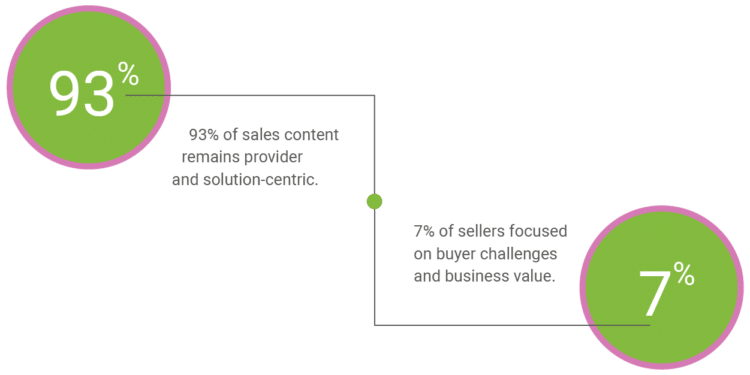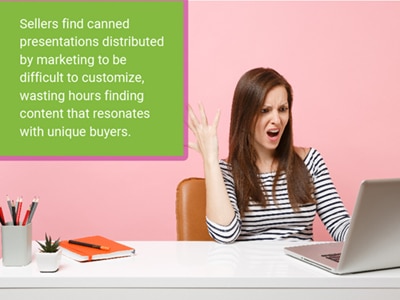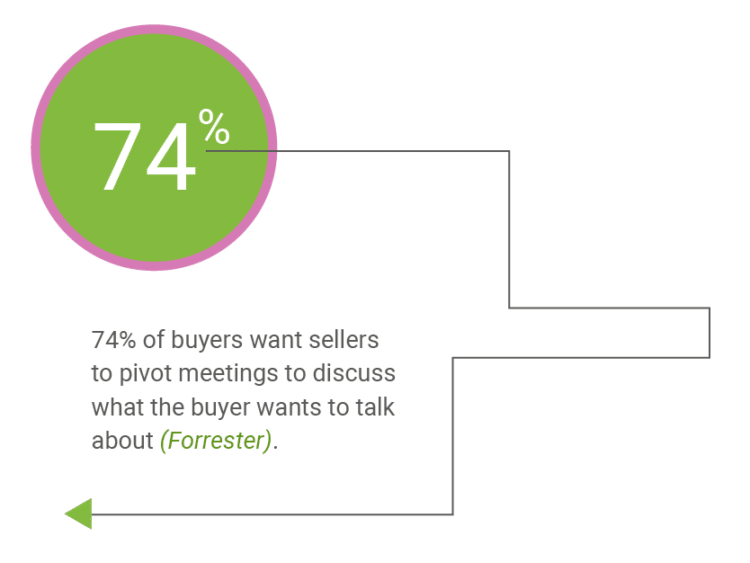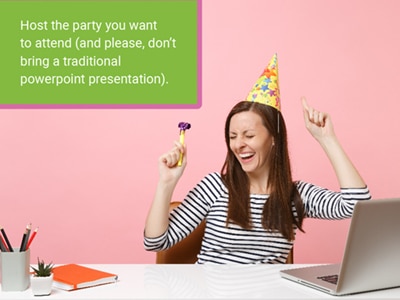If you could sit through another PowerPoint presentation or go to the dentist, which would you choose? One in three people would gladly choose the dentist chair (Zogby). The traditional sales presentation has a well-earned history of being dreaded by customers and prospects, but what’s the real reason behind its bad reputation?
93% of sales content remains provider and solution-centric, with only 7% of sellers focused on buyer challenges and business value.
A sales interaction can be likened to a party. Whether you enjoy yourself at the party depends on a few factors (after the food, of course): the environment, the host, and the level of engagement. Imagine this:
You’re invited to a party at an enormous, impressive home of someone you don’t know very well but have learned about through a friend. You’re not sure if you have shared interests with them or their other guests, but you’re excited to make some new connections. When you arrive, everything looks perfect; everyone is impeccably dressed, the flowers are arranged, there’s not a speck of dust. The host immediately sweeps you off on a tour of the amazing home, detailing the story behind the rare, imported marble, the one-of-a-kind millwork, the vast acreage. You think of sharing your love of home design, or finding out how you both decided to live in the same area, but time runs out. The host thanks you for coming and moves on to the next guest.
Many of us have been to a party like this. And not only did we not form a relationship with anyone at said party, but we’ve also likely already forgotten their names. Why? It was an exhibition, not an engagement.
Transform PowerPoint Presentations Into Strong Sales Engagements
In most cases, the challenge for marketing and sales isn’t accessible content, it’s managing its relevance and volume to build more customized, data-driven presentations. For both marketing and sales, this is difficult. Marketing has a hard time maintaining and controlling PowerPoint presentations, with little to no visibility into what is actually being presented and shared with customers. 
When the story you’re telling is solely about you, all of the content seems worth including. That means you’re left with monster-sized decks – often for multiple lines of business- that require constant updates. The heavy weight of big sales decks isn’t just way too much paper, it’s these added stressors:
- PowerPoint presentations are quickly out-of-date and hard to condense
- Lack of visibility into what is being presented and shared with customers
- Reps are wasting time wading through big decks, assembling content and customizing each presentation
- Sales presentations are traditional, long, boring and ineffective in driving provocative customer conversations and differentiating your products or services
- Reps find it difficult to seamlessly pivot presentations to address what the buyer wants to talk about in the moment
Don’t get me wrong, you have to arm your sellers with compelling content to share with prospects to fuel conversations. The key is to actually change the conversation – from “pitch” to “purpose.” When it comes to the need for value-based sales interactions, the data is in: 

There is an incredible competitive opportunity to help your prospects navigate today’s buying process, which is noisy, often complex and rarely about their needs. Sales enablement technology gives sellers the tools they need to approach sales engagements confidently, like interactive presentation tools, customized, agile content that meets buyers where they are, and prescriptive solutions backed by personalized insights. This evolution toward digital transformation not only lifts the weight of those heavy sales decks from your engagements, but also lifts the burden of administrative work from both sales and marketing. Offering these types of sophisticated tools doesn’t just enable your reps, it evolves your sales approach with sellers able to diagnose business issues for customers and prospects and then offer value-based solutions in line with what matters most to each individual buyer.
With an evolved content strategy and sales enablement solution:
- Sellers can customize decks for each engagement, adding other standard and customized slides, interactive tools, documents, video and more
- Sellers can lead with data-driven content, integrating interactive tools into each presentation seamlessly
- Content is automatically updated, eliminating the administrative need to weed out anything irrelevant
- Marketers are empowered to understand which content and stories sellers are leveraging
- Sellers are empowered to understand which content customers are consuming and sharing with decision-makers
Evolving your sales presentation from “pitch” to “purpose” brings buyers into a data-driven conversation about their unique needs. Instead of putting customers and prospects to sleep, you can quantify and communicate the impact your product or service will have on your buyer’s business, in the context of what your buyer cares about most.

Comments are closed.